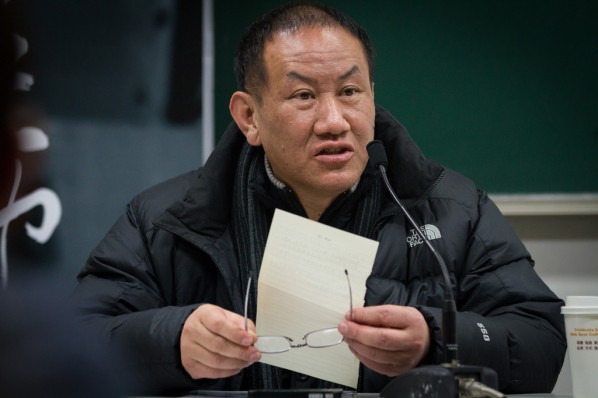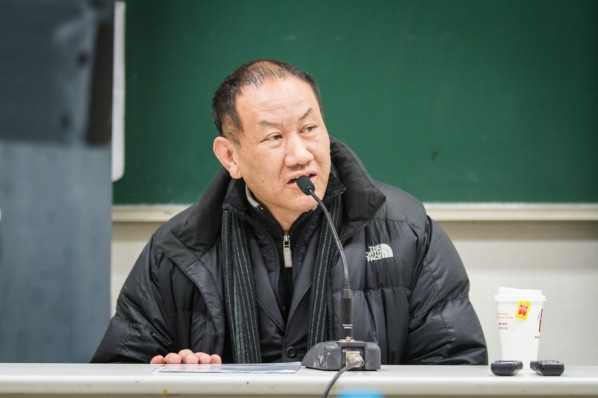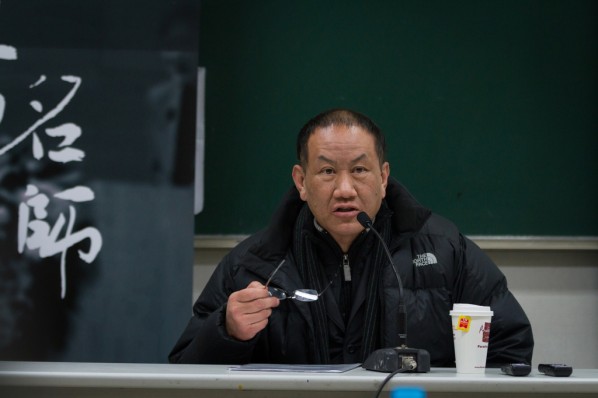
The 8th session of “Facing Outstanding Teacher” series was held at the F1-109 of Building 5, CAFA at 18:30 on December 12, 2013. Prof. Xie Dongming, Director of the Department of Oil Painting, Deputy Dean of the School of Plastic Arts, CAFA, was invited to give a lecture entitled “Ideals and Reality”.
The lecture was divided into two parts: firstly Prof. Xie gave a large number of suggestions on learning methods, secondly with the combination of his own work he shared his artistic creative experiences with the audience, and Xie believed that a student should fully understand himself before entering an academy, with a basic attitude on life and society. Art was the expression of the emotional self and cognition, teachers could not teach students how to become a successful artist, they just taught the basic creative techniques. The formation of the outlook of life required a gradual accumulation of personal experiences. A student should initiatively study when studying in an academy. Students should establish self-centred thinking, looking at things with a spirit of criticism, suspicion, proving what is right or wrong with practice. Contemporary art was sophisticated, people could make it clear only through study, thinking and practice, to find the most suitable creative styles for themselves. During this process, it was necessary for students to ignore the views of others, applying knowledge and accomplishment to establish a self-choice confidence. In the four-year study in the academy, students mainly learned the basic “creative” capabilities. It was the prime time to learn oil painting, if students failed to lay a solid foundation when they were young, they would encounter many creative issues, and become stagnant in future.

Oil painting originated from the West, and complies with the Western creative mode. There was a big difference between Chinese and Western ways of seeing, while Western styles focused on proportion, structure and perspective of the object, etc. During the process of creation, we should go beyond the appearance of things deepening into the essence, based on objective analysis, to establish the basic spatial concept in mind. CAFA had always used realistic techniques in teaching, basically covering all techniques, which had been approved of through practice, in addition long-term work was necessary for the students to learn methodically and orderly working, as well as the clear idea of legitimate arrangement for a creative process. Students should fully use the school resources, such as the library, lectures and so on. Students should not determine the direction of learning according to personal preference but should be aware of various aspects of knowledge.
In the second part, Prof. Xie introduced his works through different periods. His creations were basically divided into three stages. Firstly before and after graduation from CAFA, impact of the social thought at that time, he was very concerned with Chinese folk art. He determined to abandon the whole-factor drawing which he learned while at the academy, removing the Western system in the painting. He used some traditional techniques such as flat painting, line drawing, etc., with the combination of personal experience to literally perform it. In the actual creation, he still retained the basic elements of oil painting, such as texture, brushwork and so on, but showcasing more of the traditional Chinese folk culture. Representatives of the works of this period included “Tibet Group Paintings”, etc.

Secondly it was a stage of exploration, and Xie proposed that one should arrive at the utmost limit when exploring a style and form. He had tried a large number of methods during his exploration, and eventually found himself very interested in brushwork and color. Then he introduced the creations of the period, including Trash Can group paintings, Dummy Series, “Crying Baby” series.
Thirdly Prof. Xie’s creation was basically shaped before and after 1995. In this decade, Xie put farmers as his main theme, through painting to tell the interesting experiences during his rural travels. He borrowed the image of farmers to express his feelings. The images were original and simple, including the clarity and natural aspect that was missed in urban civilization. In addition to painting, Xie Dongming also tried many other creative forms, such as watercolor, drawing and so on. In his opinion, a good artist should have his own unique language of form, so he has been trying to create his own style, by using different materials, the audience also identify his work through traits.
Journalist: Zhang Gaoshan, Photo: Yang Yanyuan/CAFA ART INFO
Translated by Chen Peihua and edited by Sue/CAFA ART INFO




























